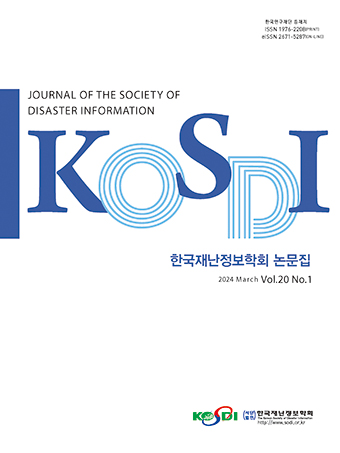Original Article
Abstract
References
Information
Purpose: Even if a damage is applied to the dust of the construction site containing the first-class carcinogen, it is dismissed or 5~30% of the amount of noise damage compensation is paid., Because of such loopholes, some construction companies are neglecting the dust management of the construction site, and the damage of the workers and the residents in the construction site continues. Method: The purpose of this study is to examine the problems of the calculation criteria of damage compensation amount of construction site dust, the measurement of dust concentration, the analysis of measurement data (the data of electric signboard measuring device by the mining scattering method), the prediction and evaluation methods such as modeling, and to suggest improvement measures. Result: It is found that it is impossible to calculate the amount of damages from dust damage in the construction site by calculating the current dust damage compensation amount and dust concentration modeling and measurement. Conclusion: It will receive an application for compensation for damage within the site where damage is expected (about 100m in the straight line and the boundary line of the site), and present a method of calculating the amount of compensation that differentially evaluates dust damage to the degree of dust management and compliance with dust-related legal standards.
연구목적: 1급 발암물질이 포함된 공사장 먼지로 인해 피해 발생 시 피해 배상 신청을 해도 기각되거나 소음피해 배상금액의 5~30%정도만 지급하고 있다. 그런 허점 때문에 일부 건설사들은 공사장 먼지관리를 소홀히 하고 있어서 공사장 내 작업자들과 인근 주민들의 피해가 지속되고 있다. 그에 대한 해결방안을 제시코자 한다. 연구방법: 공사장 먼지의 피해배상액 산정기준 문제점, 먼지 농도 측정, 측정자료(광산란법에 의한 전광판 측정기 자료) 분석, 모델링 등 예측, 평가 방법의 문제점을 고찰하고, 개선방안을 제시코자 한다. 연구결과: 현재의 공사장 먼지 피해 배상액산정기준과 먼지농도 모델링 및 측정으로는 공사장 먼지피해 배상액 산정이 불가한 것으로 드러나 개선이 시급한 것으로 나타났다. 결론: 공사장 피해가 예상되는 지점 내(부지경계선과 직선거리100m 내외)에서 피해배상 신청을 받고, 먼지관련 법적 기준인 비산먼지 억제조치기준들의 준수여부와 먼지관리 정도로 먼지피해를 차등 평가하는 배상액 산정방안을 제시한다.
- A Case Study of Environmental Dispute Mediation Casebook from 2015 to 2018. Central environmental Dispute mediation Committee
- Cho, M.-K., Yoon, H.-S. (2021). "Analysis of domestic fine dust damage and management policy." The Korean Society of Disaster Information Conference, Seoul, p. 123.
- Kim, J.-H. (2021). "A study on the reduction of fine dust through improvement of the car wash facilites on the construction site entrance." The Korean Society of Disaster Information Conference, Seoul, p. 271.
- Kim, J.-H., Kim, H.-S., Kim, Y.-S., Lee, M.-G., Rajib, P., Lee, H.-K. (2014). "Analysis of meteorological factors effect for airborne particle monitoring using optical method." The Korean Society of Disaster Information Conference, Incheon, No.1, p. 124.
- Kyeryong Construction Industry (2021). Educational Environment Assessment Report of Apartment Housing in Daejeon Yongjeon Neighborhood Park (Final Report). pp. 141-148.
- National Environmental Science Institute (2015). Air Pollutants Emission Factor - Based on Air Pollutants Emissions in 2012. p. 146.
- Schedule 14 (Standards for Installation of Facilities and Necessary Measures to Control the Occurrence of Dispersed Dust) (Ministry of Environment) of Enforcement Rules of the Air Quality Conservation Act.
- Seoul City University Air Pollution Research Center (2021). A Study on the Emission Characteristics of Fine Dust Unacidated Emission Sources and the Establishment of Management Plan. p. 21.
- Wang, S.-J., Yoon, S.-G. (2019). "Personal countermeasures for fine dust." The Korean Society of Disaster Information Conference, Seoul, p. 293.
- Yu, H.-J., Han, K.-Y., Kwak, K.-S., Kim, J.-S., Yang, K.-Y. (2004). "A study on the actual condition and effect of dust scattering in construction field." Journal of the Korea Institute of Building Construction Vol. 4, No. 4, pp. 110-112.
- Publisher :The Korean Society of Disaster Information
- Publisher(Ko) :한국재난정보학회
- Journal Title :Journal of the Society of Disaster Information
- Journal Title(Ko) :한국재난정보학회논문집
- Volume : 18
- No :2
- Pages :374-385
- DOI :https://doi.org/10.15683/kosdi.2022.6.30.374




 Journal of the Society of Disaster Information
Journal of the Society of Disaster Information







